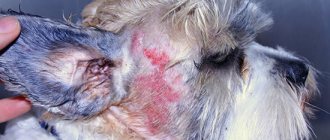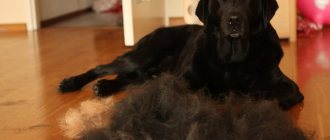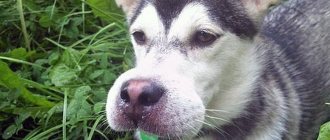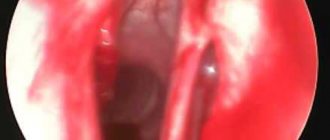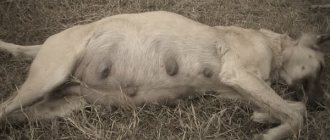Skin peeling in dogs
Peeling skin is one of the most common symptoms of various diseases in dogs.
Often owners are concerned about this, since keratinized skin particles form dandruff, which, naturally, does not contribute to the best appearance of the animal, and is also not an indicator of its health. In order to get rid of peeling skin, any veterinarian faces a difficult task, namely, to accurately determine whether the appearance of flakes of dead dermis is a secondary factor in relation to the underlying disease (which, as a rule, is one of the types of dermatoses) or whether it is directly related with a violation of the keratinization process, which may well occur even despite the absence of any health problems in the pet.
Primary defects are usually hereditary and most often appear in dogs at a young age, specifically during the first two years of life. The likelihood that a middle-aged dog will develop primary peeling is extremely low, so if your pet has already reached three or more years of age, you should think about what disease could cause this symptom.
Moreover, experts say that more than two thirds of cases of skin peeling are the result of individual diseases and are one of their clinical signs. This is why a veterinarian will only check for the possibility of primary keratinization after ruling out the possibility of other serious skin diseases.
Diseases that can cause peeling skin in dogs
If your dog's skin is peeling, this may indicate that the dog is suffering from some type of dermatosis. These diseases cause precisely the secondary type of peeling. The group of dermatoses can be roughly divided into itchy and non-itchy. However, such a classification of dermatological diseases is not 100% accurate.
Pruritic dermatoses include
Pyoderma is a purulent skin lesion characterized by severe itching, peeling, the appearance of red and yellow blisters, and alopecia. When the bubbles are opened, a strong repulsive odor is heard. For pyoderma, complex treatment is prescribed, including symptomatic therapy, the fight against pathogens and work to restore the normal functioning of the immune system.
Atopy is an allergic reaction of the skin, which in most cases manifests itself seasonally. Clinical signs of atopy include severe itching, flaking of the skin, sometimes sneezing, alopecia, skin hyperpigmentation, and red eyes.
Food allergy is an inappropriate reaction of the body to certain foods. This type of allergy is usually accompanied by itching, redness of certain areas of the skin, rashes, discharge from the eyes and nose, swelling, and sometimes diarrhea. Moreover, a long-term allergic reaction is also characterized by peeling of the skin, as well as an unpleasant odor emanating from the pet’s fur. Treatment involves eliminating the allergen from the animal’s diet and, in some cases, symptomatic therapy
Flea bite dermatitis is the most common allergic reaction in dogs. This disease is usually characterized by the following symptoms: severe itching, alopecia, significant loss of interest in food, irritability, severe vomiting and flaking of the skin. For effective treatment, it is necessary to get rid of the root cause, namely parasites on the pet’s body.
Scabies is a parasitic infection caused by small mites. Clinical signs of scabies include severe itching, spots on the surface of the skin, peeling of the dermis, nervousness, sleep disturbances, decreased appetite and, in some cases, fever. Scabies is quite easy to treat, but it should be started in a timely manner.
The absence of itching is usually characterized by diseases such as:
Pemphigus is the general name for a group of autoimmune dermatological diseases characterized by the appearance of ulcers and scabs and fluid-filled blisters and ulcers on the skin. To stabilize the pet's condition, he is prescribed steroid medications. In this case, it is better to put the dog on a diet and limit the consumption of fatty foods.
Hypothyroidism is a disease that occurs due to insufficient production of hormones by the thyroid gland. In this case, the dog experiences alopecia, dull hair, peeling skin, poor wound healing, and thickening of the skin. Treatment involves prescribing certain hormonal medications and introducing a low-fat diet.
Demodicosis is one of the most common diseases in dogs. It is caused by a special type of mite and is characterized by the appearance of redness, alopecia, low body temperature, the formation of scales, as well as the appearance of purulent discharge under them. All therapeutic measures for this disease are aimed at: destroying the pathogen - eliminating pyoderma, restoring the immune system, removing toxins, and restoring the skin.
If your dog's skin is peeling, this tendency may be a direct consequence of a pathology in which the body forms too many horny scales. This process is explained by a malfunction of the skin glands or epithelium and is hereditary. This group includes:
Seborrhea is an extremely common dermatological disease, the characteristic symptoms of which are increased oily skin and dandruff. A course of general therapy is carried out to control the animal’s condition, since it is almost impossible to cure this disease. Symptomatic therapy involves the use of special cleansing shampoos.
Zinc-dependent dermatosis - this disease in dogs is quite rare and is explained by a serious lack of zinc in the animal’s body. If the disease is at an early stage, the dog's skin peels, erythema appears, and baldness of some areas of the skin is observed. If the lack of zinc in the body is constant, the body loses the ability to quickly heal damage, the dog loses weight sharply, and the cornea of the eye becomes inflamed. The best way to prevent zinc-dependent dermatosis is to include foods high in zinc in your pet's diet.
Epidermal dysplasia is a chronic skin disease in which itching, increased fat content of the dermis and sharp thickening of the skin are observed. Most often, West Highland White Terriers suffer from epidermal dysplasia. Treatment of the disease, first of all, involves eliminating the cause of dysplasia.
Skin peeling and scratching
Here, ksanka posted in her topic:
Cheyletella are mites that are often confused with allergies. A very common insect that causes skin lesions that are usually identified as “allergies” is cheyletiella. These are mites that are not visible to the naked eye (they can only be seen under a microscope). They do not make passages under the skin; they live and parasitize on its surface. They are specifically canine, but those that live on rabbits and cats can also live on dogs; it is the latter that cause the most severe itching in dogs.
The main (visible) symptom of the lesion is flaking of the skin (dandruff). The skin of the back is most often affected. The severity of itching varies greatly among different animals. Sometimes very severe itching occurs, leading to self-injury. Young dogs and animals with immunosuppression are predisposed to infection with cheyletella. That is, even if the dog has been walking all the time in an area infected with cheyletella, it can “not pick it up” as long as it has a strong immune system. As soon as the immunity weakens, the cheyletiella are right there - they will immediately “settle” in the dog. Now we are talking about a healthy dog that does not have any hereditary pathologies. So, the question is: when can immunity weaken? -During a change of teeth, for example. -During the dog’s illness with some other disease. -If any disease was treated with glucocorticosteroids (dexamethasone, prednisolone, cortisone, betamethasone, etc.) -If the dog was stressed. In this case, the body itself begins to produce corticoids, with all the ensuing consequences. Moreover, dandruff, the cause of which is precisely cheyletiella, is almost always “written off” by veterinarians who do not particularly bother with the thought process (and, unfortunately, there are a lot of them) as an allergy, and begin to prescribe the dog antiallergic drugs and, very often, corticosteroids... Ah, as can be seen from the above, corticosteroids cause a decrease in immunity (inhibit the body’s immune system), and therefore (if the dog already has cheyletiella) will contribute to the prosperity of these skin parasites... The worst thing is that for a while corticoids will actually relieve the itching, but then the dog will only get worse... And at the end of the “treatment”, which, naturally, will not help the dog, veterinarians make a “conclusion” that your dog is so sick that it is easier to euthanize it and not torture it... By the way, about these and other consequences of the use corticoid drugs (for example, the very popular Execan, which contains dexamethasone). “The causative agent of the disease is ticks Cheyletiella vasguri, which belong to the phylum Arthropoda, class. Arachnida, neg. Acariformes; p/neg. Trombidiformes, n/sem. Cheyletoidea, fam. Cheyletidae, genus Cheyletiella. These are small oval-shaped mites. Their gnathosoma is clearly separated from the body, has the shape of a cone and has dense integument. On the sides of it there are large tentacles with five movably connected segments ending in claw-like outgrowths. The two pairs of forelimbs are somewhat distant from the two pairs of hind limbs. The tarsi of 1 pair of legs do not have claws. On the dorsal side of the body, females have one, and males have two, smooth trapezoidal shields. They are slightly chitinized and yellowish-white in color. The marginal setae are covered with hairs. Cheyletiellosis is characterized by seasonality - outbreaks are recorded in spring and autumn. Young dogs over 6 months of age and dogs with immunodeficiency are most often affected. Many sources indicate that the disease can be transmitted to humans. With cheyletiellosis, the skin of the back, possibly the groin, is usually affected, on which large “dandruff” appears, like flakes of dry skin, sometimes of quite a decent size. There is itching, the dog can chew quite hard.
Treatment: drops on the withers of Advocate or Stronghold (according to the dog’s weight) 2-3 times at intervals of 3 weeks. It is also necessary to treat all dogs and cats living with the sick animal with Stronghold (for cats - Feline Stronghold). You can treat the beds and apartment with preparations such as Butox, Neostomazan, etc. There is no need to treat the environment with anything - the tick does not live long without an animal; drops on the withers will be enough. (I would like to note that Stronghold is not a cheap drug, but trying to save money by replacing it with, for example, Frontline or Bars is useless. These drugs are ineffective against cheyletiella, relief will take many months, and in the meantime the dog will comb and chew. This will also have to be treated , buying all kinds of drugs. In general, you won’t get decent savings plus the animal’s suffering.) At the end of the course of treatment, the dog can be washed with shampoo, for example, “8 in 1 Anti-itching and dandruff,” or tar soap to wash off most of the scales. The remaining ones are completely combed out within about a month. Put on a parasite collar and wear it constantly. If, after completely cleansing the dog of “garbage”, after a short time the “dandruff” suddenly appears again - THIS IS NOT NORMAL! And it can only mean one thing – they weren’t treated enough. This means that the Stronghold treatment needs to be repeated.
Verification of the diagnosis of Heyletiella: scrape the skin, press clear adhesive tape to the affected area, then stick it to a glass slide and examine it under a microscope.
A dog affected by cheyletiellosis in an advanced form. ( on the picture)
“flakes” appeared on the fur, probably a week (or even 2) after the treatment was started... At first there was dandruff on the dog, but it was just a little bit. These flakes are essentially a sign that the treatment is helping, but many people regard their appearance as the opposite, they believe that the dog has become worse... (the conclusion is drawn: “from the treatment”). Don't expect your dog to stop itching right away. On the contrary, at first after treatment it may begin to itch more; this is normal. And there may be more dandruff - this is also normal. The “itching” should stop only after about 3 weeks. And then, that is, 3-4 weeks, it must be re-treated. Before treatment, you can wash it to remove the “dandruff”; tar soap helps a lot. The Biafar collar must be worn constantly without taking it off. Just repeat once again - the collar should not be “Bio”. And although the instructions usually state that the collars will last for a very long time, in reality the collars are only effective for about a month. And then their effect begins to weaken. After about 2 months they are completely ineffective... The dog is 2 months after treatment. Chow was cured not with the help of “rice diets”, treatments for “allergies”, “liver” and “fungi”, but with the help of only a thorough (and competent!) Treatment for skin parasites. Taken from https://ingrus.net/xejletielly.html
Diagnostics
In order to determine exactly why a dog’s skin is peeling, it is necessary to carry out a whole range of diagnostic measures. As a rule, the veterinarian strives to develop a comprehensive diagnostic plan. The first thing a specialist pays attention to is the special nature of the peeling. If it is dry, the inflammation, in turn, is weak and the itching does not torment the animal too much, most likely you are dealing with dermatophytosis, helminths, demodicosis or pyoderma. If a dog has a greasy type of peeling, characterized by severe inflammation and itching, this most likely indicates pyoderma, allergies or scabies.
Treatment of skin diseases
If the owner notices that the dog's skin is peeling, it is necessary to immediately contact a veterinary clinic for help. Any delay will only worsen the situation, and treatment will be much more difficult than in the first stages of the onset of the disease.
To prescribe adequate therapy, diagnostic studies are necessary.
Diagnosis consists of a clinical examination and the appointment of laboratory tests in case of suspicion of an infectious, parasitic, allergic or autoimmune nature of the disease.
First of all, when performing a clinical examination, the veterinarian pays close attention to the characteristic features of peeling. With dry and slightly inflamed areas of the skin, not accompanied by severe unbearable itching, suspicion arises of dermatophytosis, helminthiasis or pyoderma. In this case, the specialist takes a scraping of the skin for further research and determination of the sensitivity of the drugs.
With severe scratching, inflammation and itching, the cause most often lies in allergic reactions, scabies or bacterial infection.
Treatment should be aimed at eliminating the cause of symptoms. After an accurate diagnosis is made, an individual treatment regimen is developed.
Symptomatic therapy consists of selecting medications that eliminate inflammation and itching. For this purpose, antihistamines and non-steroidal anti-inflammatory drugs are used.
In case of bacterial infection, a course of antibiotics is prescribed, tailored to the individual characteristics of the pet (weight, health, age).
How to deal with flaky dog skin?
Based on the information presented above, every pet owner should understand that it is unlikely that they will be able to cope with the problem of peeling on their own. That is why in this case a visit to the clinic is simply necessary. If a dog has secondary peeling, that is, if this symptom arose as a result of a skin disease, adequate treatment and correct diagnosis will help to cope with this quite easily. If peeling is primary, that is, it occurs as a separate disease, it is much more difficult to cure; systemic therapy, constant monitoring by a specialist, and sometimes even lifelong symptomatic treatment will be required.
In general, flaky skin conditions in dogs can be treated before a diagnosis is made. This approach should reassure the pet owner and significantly alleviate his condition. As a rule, the main efforts of the veterinarian in such cases are aimed at treating pyoderma, which often accompanies dermatological diseases. This requires a course of antibiotics and certain antibacterial and keratolytic drugs. The first results are usually visible after about a month of active treatment. Symptomatic treatment in such cases can help to correctly diagnose the disease.
How to deal with peeling?
Dandruff is not a disease, but a symptom that requires treatment. The coat has become dull and the dog smells unpleasant. Itching may occur, and since the pet is constantly itching, a secondary bacterial infection may develop if dirt gets into the scratched wound. It is important to correctly diagnose the cause of the disease in order to eliminate it. To do this you need:
- Contact a veterinary clinic or a dermatologist;
- Give a scraping;
- Pass the necessary tests.
For treatment, as a rule, regardless of the etiology, a sick dog can be prescribed shampoo with chlorhexidine 4% from the company Apicenna.
Shampoo, evenly applied to wool moistened with warm water, at the rate of 1 ml per 1 kg, rubbed in with massaging movements until foam forms, avoid contact with mucous membranes. After 5-10 minutes, the shampoo is thoroughly washed off with warm water, the coat is dried and combed.
Antimicrobial shampoo is used for at least 3-4 weeks, every 3-5 days until the therapeutic effect occurs. The sulfate-free formula, which retains the active properties of chlorhexidine for a long time, promotes the rapid restoration of your pet’s skin. The shampoo contains lactic acid, which has the effect of speeding up cell renewal, also moisturizes, and maintains the natural ph balance of the skin and hair. Peeling of the skin, dryness and dandruff are not uncommon. Often seborrheic dermatitis cannot be completely cured, but effective prevention can and should be carried out to maintain the health of our pets. A medicinal antimicrobial shampoo with chlorhexidine 4% is suitable for this.
Remember that only your attending veterinarian can prescribe the drug. Before using the drug, you must read the instructions.
Source
Possible diseases
Peeling skin in dogs occurs in all breeds and all ages. More often it can only occur in decorative breeds prone to dermatitis. First of all, the veterinarian must exclude the following pathologies:
- Lichen. A fungal disease, infection of which most often occurs after interaction with cats. At the site of the lesion, you can notice severe peeling of the skin, which quickly transforms into a bald spot. The appearance of weeping indicates the development of dermatophytosis. Ringworm is considered a contagious lesion, prone to recurrence. To confirm the diagnosis, a microscopic examination of hair from the lesions is required. In controversial cases, a culture may be prescribed to determine the culture of the fungus. Some dermatologists claim that to make a diagnosis, it will be enough to illuminate the lesions with a Wood's lamp, and if an apple-green glow is present, treatment can be prescribed. The regimen for each dog is individual, depending on the number of lesions and the severity of symptoms. Antifungal ointments, shampoos and tablets are usually used internally. Particular attention is paid to other pets living in the house and things on which fungal spores can persist (carpets, rugs, etc.). Other pets are prescribed prophylaxis against lichen, and things should be regularly disinfected with a chlorhexidine solution. If the animal has access to bedding, it is best to boil and iron it. Separately, it is worth paying attention to vaccination against lichen, which is not recognized by most of the world's leading dermatologists and is considered ineffective!
- Demodecosis. A common occurrence among dogs of all breeds. Normally, every animal has a tick on its skin. And if their number increases sharply, then we can talk about the development of demodicosis. Such activity can be provoked by a sharp decrease in immunity due to prolonged use of antibiotics or a tumor process. Characteristic symptoms are that the dog’s skin begins to peel and hair falls out. Multiple black rashes appear in place of bald spots. The itching is usually not pronounced. In advanced cases, complete hair loss may occur. You also need to know about demodicosis that it is not contagious (it cannot be transmitted to humans or other animals). The diagnosis is based on a microscopic examination of scrapings taken from the lesions. The treatment is long, but not difficult if carried out under the supervision of an experienced veterinarian. The most effective drugs are Ivermectin and Otodectin. The dosage is selected taking into account the weight of the dog. Collie owners should be aware that any ivermectin-based medications are contraindicated for their pets!
- Allergy. The most common occurrence of skin peeling in dogs. Can be food or contact. With food allergies, the lesions are usually localized in the area of the lips, eyebrows, and eyelids. In case of contact at the point of contact with the allergen. Food allergies are more often observed in decorative breeds (Yorkshire terrier, English and French bulldogs, pugs and Shar Peis). For such breeds, table food (especially sweets) is strictly prohibited, as this can lead to hair loss, redness and peeling of the skin. If there is itching (which is observed in every second case), there is a high risk of bacterial infection. Here the problem can only be solved with the help of a strict diet and switching to hypoallergenic food. Contact allergies in severe cases manifest themselves in the form of burns. Allergens can be chemicals, some types of plastic or rubber. Here, you can only get rid of problems in the future by avoiding the potential allergen. In advanced cases, taking antihistamines (tavegil, suprastin) is indicated.
- Sarcoptic mange. Another type of tick that parasitizes the skin of dogs. Manifests itself in the form of flaky scabs in the fur and local baldness. A distinctive feature is severe itching, forcing the pet to literally tear itself until it bleeds. The presence of sarcoptes can only be confirmed by microscopic examination of scrapings from the affected areas. Effective treatment is considered to be the treatment of all animals living in the house with Stronghold and Advocate for 6 weeks.
Description of possible causes
If you look at the statistics, the lion's share of complaints that their dog has very dry skin is due to various types of allergies. Second place goes to parasites, followed by fungal and bacterial infections.
Much attention is paid to accompanying symptoms and the results of cytological and microscopic examination. This is the only way to exclude or confirm the following pathologies.
Dermatitis
Most often it leads to dryness, flaking and redness of the skin. The problem with dermatitis is that many objects and substances can act as an allergen, from a feeding bowl to a house plant to which the pet has access.
We must also not forget about flea dermatitis, which develops from bites or a reaction to flea saliva. Associated symptoms include severe hair loss (in some cases even complete baldness), severe itching and the appearance of deep wounds due to scratching.
Very often such lesions are complicated by secondary infection. If an allergy is suspected, the first step is deworming and treatment for fleas and ticks (Stronghold, Frontline, Advantage, etc.). And only then do they consider switching to hypoallergenic food.
It is more difficult if the allergen is house dust, the hair of other animals or plants in the house. In such cases, the animal awaits lifelong treatment, the main goal of which will be to achieve long-term remission.
Cheyletiellosis
A common occurrence among puppies aged 2-7 months. First, small bald patches appear in certain areas of the body; in the center of the lesions, dry skin, usually pink in color, can be seen.
As the process progresses, the dog begins to scratch itself more and more often. Dandruff appears in the fur, and an unpleasant odor may be present. The diagnosis can be confirmed by microscopic examination of scales or dandruff from the affected areas.
There is also a working scheme using the drug Stronghold, which is applied to the withers 3 times over 3 weeks. An excellent solution in the fight against cheyletiellosis. But, remember that treatment can begin no earlier than 6 weeks of age (it is possible earlier, but then the dosage must be calculated by a doctor). And finally, the most unpleasant thing is that a person may develop itchy papules the size of a pea due to cheyletiellosis.
Demodicosis
Another type of mite that can cause dry skin on your dog. The main difference from cheyletiellosis is the absence of itching and redness. But, there are also bald patches (in advanced cases there is even complete baldness), in the center of which you can see black grains.
Dandruff appears in the fur, and the skin becomes covered with white scales. Very often complicated by a bacterial infection. However, the activity of demodicosis is dangerous because it is always provoked by something. And usually these are serious reasons (tumors, recent surgery, long course of antibiotics, childbirth, estrus).
In puppies, demodicosis can cause hormonal imbalances. Therefore, it is rarely treated; almost always all symptoms go away on their own. In adult pets, everything depends on the number and severity of lesions.
For example, generalized forms always take a long time to be treated (1-4 months) and there is a risk of relapse. Preparations based on Ivermectin have good reviews, but it is contraindicated for some breeds, so it is better to consult a veterinarian before taking it.
Acanthosis nigricans
A hereditary disease that mainly affects the Dachshund breed. Can appear at any age. Dry skin appears in the armpits, groin, and abdomen. As the process progresses, it darkens and becomes even rougher. In these places, hair falls out (if it was present there). Itching is rare.
In advanced cases, the lesions turn black and become covered with a hard crust. If the disease manifests itself in the first year of life, it is considered primary acanthosis. If during life, then secondary acanthosis, which is most likely triggered by allergies or bacterial infections.
In any case, if acanthosis is suspected, a differential diagnosis with allergies is made. It is necessary to take scrapings from the crusts for cytological examination to exclude bacterial and fungal infection.
Peeling skin in a dog photo
If a dog has flaky areas on the skin, be sure to rule out helminthic infestation and bacterial inflammation. In rare cases, alopecia may be diagnosed, which is considered a hereditary disease.
What allergens cause dry skin on dogs?
Dogs, like people, are sensitive to the environment, parasites and bacterial infections. When a dog has dry skin, it may be a sign of an allergy or illness that changes the condition of the skin and coat.
Recurrent dryness can be prevented with proper treatment before it becomes a long-term problem. When a dog shows signs of dry skin, understanding where the problem begins is the key to the best treatment plan for your pet.
Causes of Dry Skin on Dogs
| Problem | Reason | Signs |
| Parasitic | Fleas, lice, mites Sarcoptes disease | Scabies |
| Seasonal | Changes in the weather | Peeling, dry skin or weeping eczema |
| Fungal infection | Ringworm and yeast | Numerous skin problems |
| Behavioral | Stress, boredom and anxiety | Licking, hair loss, skin infections |
| Power | Food | Itching or rash |
| Hormonal | Disturbances or hesitations | Numerous skin problems |
| Environment | Cleaning and care of products | Gnawing on paws, constant licking |
| Bacteria | Excessively licks skin | Tender, red spots, hair loss |
| Thrush | Chewing on skin, mostly paws | Oily or flaky skin, body odor |
Types of skin diseases in dogs with descriptions and photos
There are so many skin diseases that affect dogs that it is simply impossible to present all the available information about them in one article. However, there is a group of dermatological diseases that are most often diagnosed in dogs. It includes pathologies caused by parasites and fungi, as well as diseases of bacterial and allergic etiology. They all have different causes and are accompanied by different symptoms.
Parasitic pathologies: causes and symptoms
The development of this type of skin disease in dogs is provoked by various external parasites that live on the animal and feed on blood, epithelium, and keratinized cells. Fleas, ticks, lice eaters and other blood-sucking insects not only lead to dermatological problems, but are also carriers of dangerous diseases. The most common pathologies of this group are flea dermatitis, demodicosis, and sarcoptic mange. Information about them is presented in the table:
Fleas on a dog
- severe itching - in order to relieve it, the dog constantly itches with its paw, tears the skin with its claws, tries to gnaw fleas out of the fur on the body or tail, as a result of which wounds, scratches, and abrasions appear on the skin;
- dullness and hair loss;
- swelling of the skin at the bite sites;
- small blisters;
- ulcers;
- rashes;
- dandruff;
- loss of appetite;
- lethargy;
- decreased physical activity;
- indigestion, possible vomiting.
The presence of flea dermatitis can be determined visually. Clusters of fleas are clearly visible on the animal's skin. As a rule, they are localized in the back of the body, on the withers, chest, stomach, and paws.
- red spots;
- thickening and hyperemia of the affected areas;
- unbearable itching;
- bubbles with reddish-clayey contents, in the place of which, after their integrity is damaged, bald spots form;
- sticking and hair loss;
- apathy, lack of response to external stimuli;
- refusal of food;
- slight decrease in body temperature;
- weight loss.
- constant itching;
- rashes on the head, face, ears, back, legs;
- bubbles with a clear liquid inside, if the integrity of which is violated, scales and dry crusts appear;
- baldness;
- keratinization and thickening of the skin in areas of intense scratching;
- dandruff;
- purulent sores and ulcers;
- unpleasant sour smell;
- apathy giving way to irritation and aggression;
- refusal of food.
Sarcoptic mange
Fungal diseases
Opportunistic agents are activated exclusively in the presence of factors favorable to their vital activity, but unfavorable to the dog’s health. This occurs against the background of a decrease in the pet’s body’s defenses, improper care and feeding, and helminthic infestation.
How to Prevent Your Dog's Dry Skin
The most common cause of dry skin is dehydration. Make sure your dog always has access to fresh, clean water to drink throughout the day.
The best way to prevent dry skin is to maintain your dog's coat and skin so that he is healthy and comfortable in it. Take a look at some of the simple ways to prevent dry skin on dogs.
- Be sure to use a flea and tick preventative.
- Use hypoallergenic dog shampoo when preparing it and PET-clean solutions to clean your home.
- Provide it in dog food that has no artificial ingredients and is considered supplements or special foods that contain essential fatty acids.
- Keep him away from other dogs who may be showing signs of ringworm.
- Clean your coat regularly.
- Keep your home hydrated.
Learn more about dog health from experts. Subscribe to the daily newsletter.
Diagnosis and treatment
A treatment regimen is developed by a veterinarian only after determining the cause of the development of dermatological pathology and making an accurate diagnosis (information on the diagnostic procedures performed for this is presented in the table below). To facilitate this task, the doctor will be helped by the information received from the owner of the four-legged patient regarding how long ago the symptoms of the disease appeared, what diseases the animal suffered in the past, whether vaccination and deworming are carried out regularly.
Why does a dog's skin peel - causes and treatment: Review + Video
The occurrence of flaking or dandruff on the skin of dogs leads to concern for their owners. In appearance, the peeling resembles dandruff, which spoils the dog’s appearance and causes him discomfort. Peeling in dogs is quite common and there are several reasons for this. Therefore, if your dog’s skin is peeling, you should first find out the cause, and then begin treatment.
There is no need to be nervous about flaking dog skin in advance, since it is mainly associated with diseases caused by infections or parasites. If a dog loses hair on its back, it may be due to an allergy to certain foods or due to the characteristics of the animal.
Instructions for using Essential drops
The method of using this vitamin product in the form of pipettes is completely simple. It is necessary to apply the contents of 1 pipette to the pet’s skin between the shoulder blades in several places for 2 months, once every week. After two months of treatment, to consolidate the result, you should treat the skin with 1 pipette of the substance every two weeks. It is not advisable to bathe the animal for 2 days before and after treatment.
Indications
Essential 6 spot on dermoscent is prescribed to dogs and cats to care for the skin and coat, to moisturize and reduce flaking of the skin, to eliminate unpleasant odors from animal hair, to reduce hair loss and stimulate hair growth
Possible causes of peeling skin
IMPORTANT! If, in addition to peeling, there are any other symptoms that bother you, you should immediately contact your veterinarian. He will prescribe appropriate therapy. Several types of dermatoses, which are divided into itchy and asymptomatic, can cause skin peeling in dogs.
Possible causes of dandruff are infections and systemic diseases that develop due to autoimmune or genetic damage.
Diseases that may cause skin peeling in dogs:
- Pyoderma is an infection caused by bacterial microbes. It manifests itself against the background of hormonal imbalances or helminth infection. In this case, small pustules appear on the dog’s skin, after which the skin begins to crack and peel.
- Follicular dysplasia of black hair. This disease is genetic and extremely rare. This disease can be recognized by the loss of black hair, in the place of which flaky skin remains.
Canine distemper is an infectious disease mainly found in puppies. Dogs are vaccinated against distemper, so you don't have to worry if your pet is on schedule for vaccinations. In addition to general malaise, the disease is accompanied by peeling and cracking of the skin near the eyes.
Flea dermatitis is an allergy to bites. When bitten by parasites, the skin becomes very itchy and itchy. Symptoms are redness and alopecia, severe itching in the scalp, on the nose, and sometimes the formation of ulcers.
- Hypothyroidism is a hormonal disease. It is associated with disruption of thyroid hormones. Signs include general dry skin, seborrhea and flaking.
- Impetigo is a disease caused by staphylococcus and streptococcus infections. Symptoms include a large number of pustules, inflammation and peeling of the top layer of skin.
- Lupus erythematosus is an incurable disease. Symptoms include redness and flaking of the skin, as well as other more dangerous non-skin related symptoms.
Prevention of occurrence and methods of eliminating dandruff in dogs
- Shampoos and moisturizing conditioners
- Use of fatty acids in nutrition
- Indoor air humidification
- Stimulation for water consumption
- Regular dog grooming
Shampoos and moisturizing conditioners
You can help prevent dandruff in dogs by using special shampoos and moisturizing conditioners. They can also be used to treat animals that already have dandruff. A medicated bath with shampoo or conditioner gives very quick results, soothing the skin. The most effective products are those containing aloe or oats. Aloe and oat gluten moisturizes the skin, absorbs allergens and anesthetizes the upper layers of the skin when they are damaged, eliminating itching.
Use of fatty acids in nutrition
Adding fatty acids to your dog's diet also prevents dandruff. It is advisable to use Omega 3 and Omega 6 fatty acid supplements daily, especially in dogs with long, fluffy, thick coats. Large amounts of these acids are found in fish oil, salmon oil and mink oil. The advantage of using such supplements is that these products also have a beneficial effect on joint mobility, improving the quality of articular surfaces and synovial fluid.
Indoor air humidification
Additional humidification of the air in the room where the dog is also reduces the dryness of its skin and, therefore, reduces the risk of dandruff. This problem is most pressing in the winter months, when heating appliances are running and dry the air. Installing an air humidifier will be beneficial for both the dog and its owners.
Stimulation for water consumption
All animals, including dogs, are approximately 70% water. A decrease in its amount in the body, for one reason or another, primarily affects the condition of the skin. Many dogs do not consume enough water and suffer from chronic dehydration, which leads to dry skin and dandruff. It is important that your pet consumes a sufficient amount of fluid, since its absence also leads to diseases of the kidneys and other organs. But many dogs deliberately refuse water. In such cases, you need to add additional water to their diet. Special drinking bowls in the form of fountains or special streams where water circulates constantly give a good effect. The sound of running water encourages dogs to drink.
Regular dog grooming
Special sprays for hair give good results in preventing dandruff in dogs They are applied to the dog's coat immediately after combing it. Using combs and combs is preferable to brushes as they remove dead hair more effectively and massage the skin better. Regular combing of the coat not only removes old dead hair, but also provides the skin with oxygen and improves metabolic processes in it.
Preventing the appearance of dandruff in a dog or starting treatment on time is the key to the pet’s health, beautiful appearance and peace of mind for its owners.
Prevention
NOTE! In order not to encounter unpleasant peeling on your pet’s skin, it is necessary to follow preventive measures.
The most important thing you need to do is to follow the vaccination schedule for your dog, and also carry out deworming treatment at prescribed intervals.
The next important point is the dog’s nutrition, which must be correct and balanced.
The dog also needs to be examined by a veterinarian for early detection of possible diseases. If you notice even a slight concern in your dog in the form of dandruff or itching, you should immediately contact a veterinarian to identify the causes and further consultation.
Possible diseases
Peeling skin in dogs occurs in all breeds and all ages. More often it can only occur in decorative breeds prone to dermatitis. First of all, the veterinarian must exclude the following pathologies:
- Lichen. A fungal disease, infection of which most often occurs after interaction with cats. At the site of the lesion, you can notice severe peeling of the skin, which quickly transforms into a bald spot. The appearance of weeping indicates the development of dermatophytosis. Ringworm is considered a contagious lesion, prone to recurrence. To confirm the diagnosis, a microscopic examination of hair from the lesions is required. In controversial cases, a culture may be prescribed to determine the culture of the fungus. Some dermatologists claim that to make a diagnosis, it will be enough to illuminate the lesions with a Wood's lamp, and if an apple-green glow is present, treatment can be prescribed. The regimen for each dog is individual, depending on the number of lesions and the severity of symptoms. Antifungal ointments, shampoos and tablets are usually used internally. Particular attention is paid to other pets living in the house and things on which fungal spores can persist (carpets, rugs, etc.). Other pets are prescribed prophylaxis against lichen, and things should be regularly disinfected with a chlorhexidine solution. If the animal has access to bedding, it is best to boil and iron it. Separately, it is worth paying attention to vaccination against lichen, which is not recognized by most of the world's leading dermatologists and is considered ineffective!
- Demodecosis. A common occurrence among dogs of all breeds. Normally, every animal has a tick on its skin. And if their number increases sharply, then we can talk about the development of demodicosis. Such activity can be provoked by a sharp decrease in immunity due to prolonged use of antibiotics or a tumor process. Characteristic symptoms are that the dog’s skin begins to peel and hair falls out. Multiple black rashes appear in place of bald spots. The itching is usually not pronounced. In advanced cases, complete hair loss may occur. You also need to know about demodicosis that it is not contagious (it cannot be transmitted to humans or other animals). The diagnosis is based on a microscopic examination of scrapings taken from the lesions. The treatment is long, but not difficult if carried out under the supervision of an experienced veterinarian. The most effective drugs are Ivermectin and Otodectin. The dosage is selected taking into account the weight of the dog. Collie owners should be aware that any ivermectin-based medications are contraindicated for their pets!
- Allergy. The most common occurrence of skin peeling in dogs. Can be food or contact. With food allergies, the lesions are usually localized in the area of the lips, eyebrows, and eyelids. In case of contact at the point of contact with the allergen. Food allergies are more often observed in decorative breeds (Yorkshire terrier, English and French bulldogs, pugs and Shar Peis). For such breeds, table food (especially sweets) is strictly prohibited, as this can lead to hair loss, redness and peeling of the skin. If there is itching (which is observed in every second case), there is a high risk of bacterial infection. Here the problem can only be solved with the help of a strict diet and switching to hypoallergenic food. Contact allergies in severe cases manifest themselves in the form of burns. Allergens can be chemicals, some types of plastic or rubber. Here, you can only get rid of problems in the future by avoiding the potential allergen. In advanced cases, taking antihistamines (tavegil, suprastin) is indicated.
- Sarcoptic mange. Another type of tick that parasitizes the skin of dogs. Manifests itself in the form of flaky scabs in the fur and local baldness. A distinctive feature is severe itching, forcing the pet to literally tear itself until it bleeds. The presence of sarcoptes can only be confirmed by microscopic examination of scrapings from the affected areas. Effective treatment is considered to be the treatment of all animals living in the house with Stronghold and Advocate for 6 weeks.
Peeling skin in a dog photo
If a dog has flaky areas on the skin, be sure to rule out helminthic infestation and bacterial inflammation. In rare cases, alopecia may be diagnosed, which is considered a hereditary disease.


